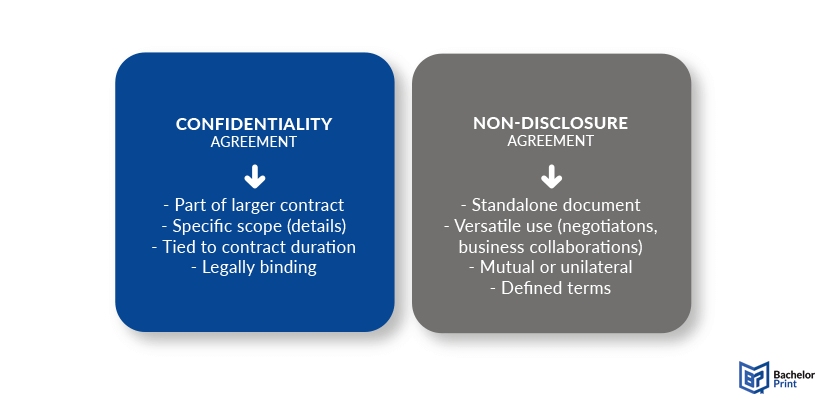
In an age characterized by the rapid exchange of information, the importance of safeguarding sensitive data and proprietary knowledge has become paramount. In the realm of academic writing, this imperative is exemplified by the inclusion of confidentiality clauses in research theses. To get a more profound grasp of this topic, we’ve provided some helpful samples for you.
Definition: Confidentiality clause
A confidentiality clause is a provision in a contract that requires one or more parties to keep certain information secret and not disclose it to third parties. It can be used in confidentiality agreements, such as employment contracts or in non-disclosure agreements, e.g., in business or legal settings.
This clause identifies the specific information that is to be kept confidential, outlines the scope of the parties’ obligation to maintain secrecy, the duration of this obligation, and any exceptions to confidentiality. It often includes the consequences or penalties for breach of contract or the clause itself. Confidentiality clauses are commonly used in contracts, business contracts and agreements, and other situations where sensitive information needs to be protected. It contains the following aspects:
- Definition of confidential information
- Obligation to maintain confidentiality
- Signatures on contracts
- Acknowledgments
- Duration of confidentiality
- Consequences of breach
- Contact information
- Dispute resolution
- Exceptions
Types of confidentiality agreements
Confidentiality clauses may be essential in a wide range of industries and fields beyond academic writing, serving to safeguard sensitive data. Below, you’ll gain a more profound insight into the situations where the use of these clauses is warranted. These kinds of agreements can be included in various types of contracts, even the most basic ones. Moreover, they can range from being clear and concise to being highly detailed and specific.
Technology & Innovation
In the tech and innovation sectors, companies often develop valuable intellectual property, such as algorithms, product designs, trade secrets, or research and developments efforts. These clauses can help to protect these assets from being disclosed to competitors or the public. Furthermore, they create a framework of trust, allowing these parties to share sensitive data or ideas, while minimizing the risk of disclosure.
Pharmaceuticals & Healthcare
Imagine the following situation: You are conducting research for a project involving a vulnerable population, such as HIV patients. In this case, you should incorporate a comprehensive confidentiality clause into your study protocols. They serve to affirm that all provided information, including but not limited to the identities of participating individuals, will be kept confidential and won’t be disclosed to anyone.
Mergers & Acquisitions
In merger and acquisition talks, confidentiality clauses are used to keep important financial and strategic information secret. In this case, the company protects itself from data misuse and the unauthorized sharing of information, which could potentially cause significant harm to the company.
Confidentiality clauses in academic writing
One of the frequently encountered types of relationships covered by a confidentiality clause involves employers and employees. In an academic context, it refers to a provision or section within an academic document or agreement, such as a thesis, academic paper, or dissertation. It outlines the terms and conditions governing the protection of sensitive or proprietary information. This clause establishes rules and expectations regarding the confidentiality of certain data, findings, or information related to the academic work. These clauses are crucial in academic writing, as they safeguard intellectual property, promote trust among collaborators, and ensure that valuable research remains protected while allowing for necessary information sharing within the academic context. This implies that the content will exclusively serve the purpose of data collection and forming assumptions, but will not be utilized as illustrative material or published alongside the main paper. Moreover, confidential information may alternatively be presented exclusively within a distinct appendix. In such instances, the option to leave this appendix unpublished is available.
Confidentiality clause samples
Below, we’ve enhanced three samples of confidentiality clauses for you as download templates!
Confidentiality clause vs. Non-disclosure agreement (NDA)
A confidentiality clause is part of a broader contract covering various topics, while a non-disclosure agreement (NDA) is a standalone document focused solely on the confidentiality of information. Confidentiality clauses are integrated into agreements that might also include employment, partnership, or sales terms. NDAs are detailed, specifying what counts as confidential, how it has to be handled, and the duration of confidentiality. Both are legally binding, but they differ in scope and application: confidentiality clauses address confidentiality within a wide contractual relationship, whereas NDAs are dedicated to protecting sensitive information in specific situations or settings, such as the music industry or employment situations.

Pros & Cons
Confidentiality clauses protect sensitive information shared between relevant parties within a larger contract, ensuring it is not disclosed to unauthorized parties. This integration leverages the contract’s legal framework, providing strong enforcement. The flexibility to tailor clauses to specific needs ensures comprehensive coverage. However, they can complicate negotiations, requiring extensive legal counsel and increasing contract prep time. If the main contract is disputed or terminated, enforcing confidentiality becomes challenging. Additionally, overlapping clauses in multiple contracts can also create confusion and increase contract tasks, risking exposure to unauthorized parties or inclusion in public records. Here’s a quick overview of the pros and cons of confidentiality clauses:
Pros
- Protects sensitive information
- Strong enforcement
- Customization
- Long-term protection
Cons
- Limited applicability
- Complexity and preparation time
- Enforcement challenges
- Management difficulties
- ✓ 3D live preview of your individual configuration
- ✓ Free express delivery for every single purchase
- ✓ Top-notch bindings with customised embossing

FAQs
It is a part of a legal agreement, document, or contract that outlines the rules regarding the protection of sensitive data. In this agreement, at least two parties commit not to disclose any information regarding the mentioned clause to the public and also define its duration and the penalty for breach. They are used to protecting sensitive information from the public or unauthorized people.
A confidentiality agreement is a legal document between two or more parties that bars the parties from disclosing the information stated in the document. On the other hand, a confidentiality clause is a part of the agreement that indicated the terms of confidentiality and not the entire document. A confidentiality clause can also be part of other non-legal documents like academic writing like a thesis.
The way you write it depends on the objective and the document of which the clause is part. However, in academic writings, some key elements that need to be included in the clause include; identification of parties, the definition of what is defined as confidential, and the scope of confidentiality. The clause needs to be easy to understand, on point, and reassuring.
A confidentiality agreement is also referred to as a non-disclosure agreement. It is a legal contract written between two or more parties. The agreement lays out the binding terms and conditions of a working relationship. The agreement prohibits both parties from disclosing any proprietary or confidential information to other people. The agreement can be mutual or unilateral. Mutual agreements are where both parties are obligated to maintain secrecy, while unilateral contracts are where only the receiving party is obliged to maintain confidentiality. NDAs are legally enforceable contracts.
It is enforceable only if either party violates the terms of the agreement as stipulated in the clause. Note that for the clause to be enforceable, the violation has to be directly related to the terms on the clause. Its enforceability also directly related to the legality of the document in which the clause is part of.
